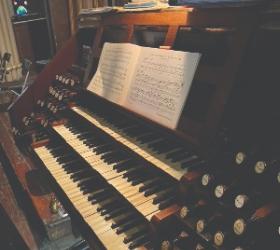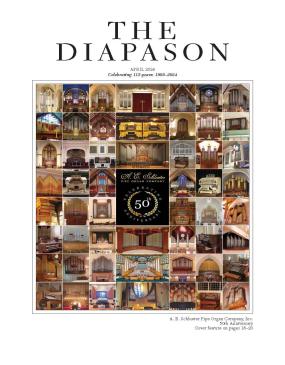
The Haarlem International Organ Festival (July 12–26, 2014) celebrated a milestone with its 50th Improvisation Competition this summer. The festival runs concurrently with the Haarlem Summer Organ Academy, which celebrated its 46th anniversary. At the academy, fifteen teachers taught eleven subjects, and it was attended by 110 students from 30 countries. In addition to these classes there were around forty public events: recitals, lectures, masterclasses, and excursions to other cities. These could easily have accounted for every minute of every day, and it would have been a challenge to justify missing any of them. The centerpiece of the festival is the famed 1738 Müller organ at St. Bavo’s (restored by Marcussen, revoiced by Flentrop, and played by Mozart), but organs all around Haarlem are used for classes and concerts, including the Cavaillé-Coll at the Philharmonie and instruments at the Nieuwe Kerk, the Waalse Kerk, and the Doopsgesinde Kerk.
To celebrate the event the organizers released The Haarlem Essays, a marvelous 480-page book (noted in the October 2014 issue of The Diapason and available through the Organ Historical Society). It contains essays and interviews directly related to the festival, to its instruments, and to its important figures over the years, and is an invaluable resource for anyone interested in the history of this important festival. But it also includes essays on a variety of scholarly, historical, and aesthetic issues by noted scholars and performers, most of which are newly written, and which makes the volume of great interest beyond the subject of the festival itself.
The Haarlem Essays comes with a compact disc of seven of the winning organ improvisations, dating back to Piet Kee’s in 1955, as well as all of the competition themes starting with the first one in 1951. The theme for the finals of this summer’s competition was by Dutch composer Louis Andriessen. It appeared about an hour before the competition and thus was too late to be included. The two top prizewinners were Lukas Grimm, from Germany, who received the audience prize, and David Cassan, from France, who won first prize. They treated the theme so differently that it seemed to me to represent two entirely contrasting conceptions of improvisation: Grimm’s was dazzling in its variety of styles and techniques and built to a thrilling conclusion, while Cassan’s was more of an integrated whole in four large sections, with thematic recurrences as well as a polyphonic elaboration of the theme. Both were remarkable and hard to compare.
At the academy there were four Bach teachers: Ton Koopman, Masaaki Suzuki, Michael Radulescu, and Jon Laukvik, and there were classes by Olivier Latry on Messiaen, Lorenzo Ghielmi on Italian-influenced North German music, Jon Laukvik on Vierne, Louis Robilliard on Franck, Luigi Ferdinando Tagliavini on Italian repertory, Bernhard Haas on contemporary repertory, Leo van Doeselaar on Mozart and Bach’s sons, Jürgen Essl and Peter Planyavsky on advanced improvisation, and Jos van der Kooy on improvisation for beginners.
After a week of two-hour masterclasses it would be foolhardy to try to describe a teacher’s approach in a sentence, but I will try to anyway for the classes I took: Suzuki’s Bach was physical and extrovert in its emotion, and he was both practical and dramatic in his teaching. At one point he had a student playing pleno forearm clusters on the Müller to encourage her to be more physically engaged. I was scared to look over the balcony to see how the tourists were taking it. Radulescu brought great scholarship to his Bach class and showed how understanding rhetorical terms and an awareness of formal and historical issues can illuminate performance. Luigi Ferdinando Tagliavini first taught at Haarlem in 1959 (where he was known as a member of the “holy trinity” along with Marie-Claire Alain and Anton Heiller). He returned this summer after a long absence, and it was a privilege to experience the elegance and generosity of his teaching and playing. His admission that he’s still uncertain about whether to normalize accidentals was liberating. Ghielmi’s class, which focused on Buxtehude and Bruhns, showed how drama and imagined operatic scenes can bring this repertory to life (a subject that Jean-Claude Zehnder also treats in his article in The Haarlem Essays), and also how a teacher with a sense of theater can entertain as well as instruct. And Haas’s inspiring class on contemporary repertory brought a level of belief and insight into the modernist repertory that I haven’t encountered in this country in a while, whether he was discussing Cage and the Buddhist conception of silence (not absence of emotion but its foundation), Schoenberg, or Messiaen.
There were excursions between the two weeks of classes, to Utrecht, Amsterdam, and Leiden. At the Nikolaikerk in Utrecht, where festival leader Stephen Taylor was the organist for many years, Christoph Wolff gave a fascinating presentation on the work of the Bach Archive in Leipzig, including the newly discovered document that shows that Bach studied with Georg Böhm when Bach was a student in Lüneberg and may very well have lived in his house.
Many of the faculty gave forty-five-minute public lectures on a variety of topics. I’ll just mention two of them: Jon Laukvik’s lecture on tempo rubato focused on an aspect of early performance that we tend to ignore but which is well documented. He noted that historical performance practice uses “a small slice of the cake.” Christoph Wolff and Ton Koopman gave a joint talk on Bach in which Koopman reiterated his belief that Bach never used heels (well, with the exception of perhaps six places, according to Koopman). It would have been fun to have had the entire Haarlem faculty in on that topic, as none of them seem to agree with him. Forty-five minutes isn’t enough to deal with the questions that any of these lectures raised, let alone the topic of heels in Bach. But what a great way to both observe the masterclass teachers in a lecture setting and to raise the intellectual level of the conference by at least starting important discussions.
Stephen Taylor, chairman of the artistic council, is the guiding spirit of this most remarkable festival and is a most genial and ubiquitous presence. His introductions to all of the events were models of brevity and wit, but if you engaged him in conversation on any seemingly trivial topic you would discover that he’s something of a polymath, and subjects like neo-Gothic architecture or the history of the Dutch canals are likely to come up. That’s another recommended way to spend your time, if you have any energy left over from the festival.
All photos by Martin Goldray except as noted.




